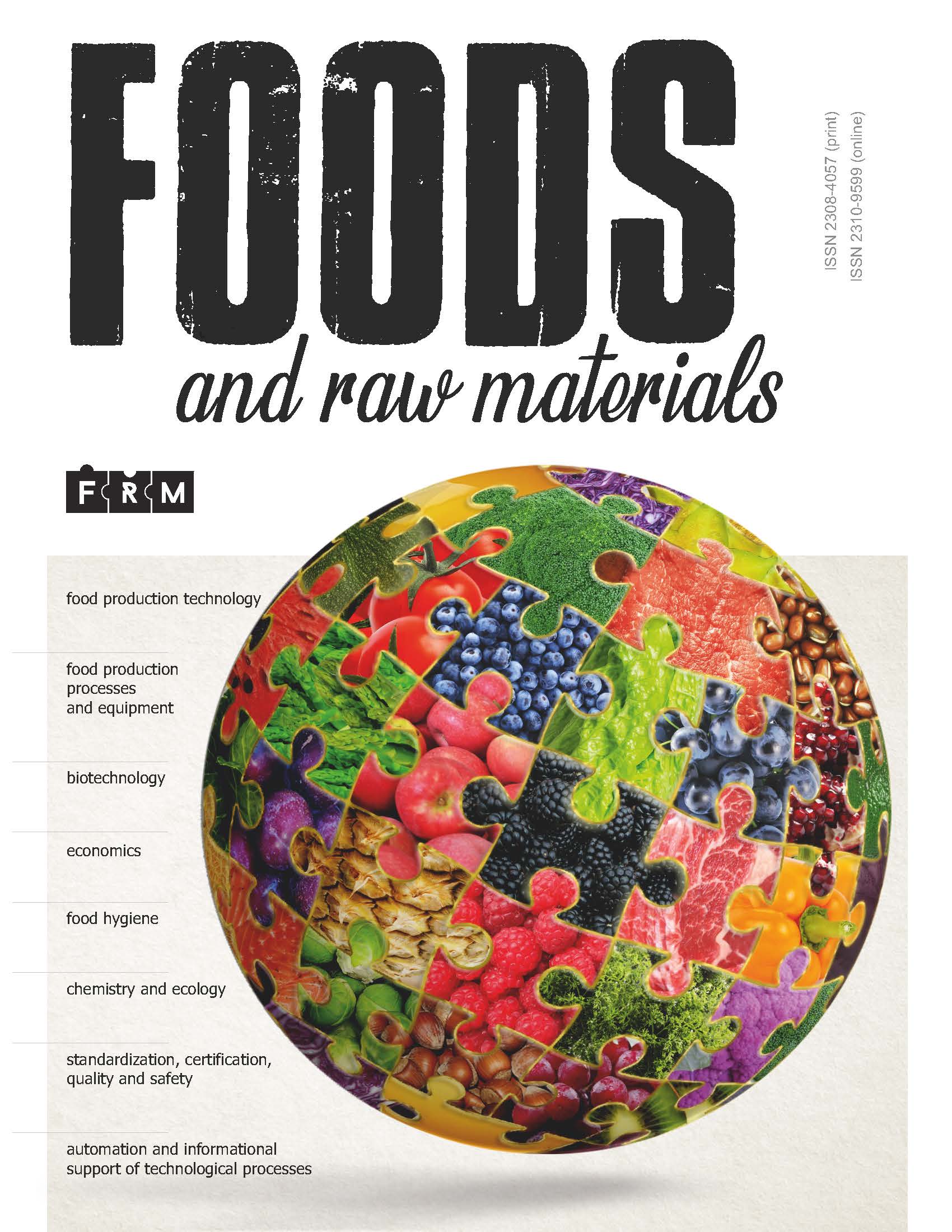Kemerovo, Kemerovo, Russian Federation
Reducing the calorie content of everyday food, including dairy beverages, is among the key recommendations of present-day dietitians. However, fat reduction worsens the organoleptically evaluated texture and flavor score of food. The organoleptic correction of nonfat products using fat simulants often needs additional financial inputs. Furthermore, fat simulants added to the product can be hazardous to human health. Taking into consideration these facts, we have developed a casein microparticulation technology and have investigated the possibility of employing microparticulated casein in the production of nonfat fermented dairy beverages. Unlike the existing milk protein microparticulation technologies, the technology presented here uses casein in place of whey protein, which is difficult to produce and, as a consequence, expensive. A casein coagulation method has been devised, and the optimal processing parameters have been determined. A technology for producing nonfat lapper milk from skim milk has been developed. The new product has the same texture and flavor as its analogue containing 3.2 wt % fat.
microparticulation, casein, renneting, fat simulant, viscosity, active acidity, enzyme.
INTRODUCTION
The rapid progress in engineering and technology has markedly reduced the amount of manual labor in the present-day society. The decreased physical activity and sedentary lifestyle combined with traditional dietary patterns leads to overweight and obesity, which can cause so-called diseases of civilization, such as hypertension, coronary heart disease, insult, gallbladder diseases, osteoarthritis, dyspnea, rectal cancer, and diabetes [1].
The problem of instilling the culture of consumption in people and that of changing their dietary patterns should be solved at all society levels, including the government. Of great importance for solving the latter problem are public awareness of the principles of a healthy balanced diet and production of low-calorie foods.
A significant decrease in the calorie content of food can be achieved by reducing the amount of fat, the highest calorie component, whose energy value is more than two times higher than that of proteins and carbohydrates, the more so because milk fat is not an indispensable component of food from the standpoint of nutritional value.
However, low-fat dairy products may have some defects, for example, flat taste, too thin texture, and too coarse texture with signs of mealiness and curd grains (for protein foods) [2]. The nutritional value of food is of obvious significance, but the consumer's choice is actually governed by the organoleptic properties of food.
In practice, the organoleptic properties of nonfat foods is increasingly being corrected using fat simulants, which are low-calorie substances creating the illusion of the presence of fat. This property of fat substitutes is due to their particles falling in the size range from 0.5 to 2.0 μm and having a spherical or near-spherical shape. This is the reason why foods containing fat substitutes provide a creamy mouthfeel when they are masticated. Particles larger than 3 μm in aqueous dispersion are perceived as powdery, chalky, and sandy (as their size increases), and dispersed particles smaller than 0.1 μm are perceived as a true solute [3].
Fat simulants differ in their nature and may be based on a carbohydrate, protein, or fat or on their combination.
Carbohydrate-based fat substitutes are produced from natural gums, agar, modified starch, or corn fiber. They absorb water, thus imitating the fat volume and structure, and are used in the production of pastry, convenience meat products, spreads, soups, salad seasonings, glaze, and frozen desserts [4].
Protein-based fat substitutes are produced by heating and grinding (microgranulation) of milk and egg proteins or a mixture of egg and whey proteins and xanthan gum. They are unsuitable for foods whose preparation involves high-temperature treatment, because the proteins undergo denaturation at elevated temperatures, their structure breaks down, and they lose their ability to simulate fat [5].
The method of producing microgranulated whey protein (MWP) was developed in 1984 by the Canadian inventors Norman S. Singer, Shoji Yamamoto, and Joseph Latella [6]. The microgranulated protein Simplesse®-100 is readily dispersible and dissolves rapidly without use of specialized equipment or technology; it acts as an ersatz dispersed phase in place of the fat droplets that traditionally function as the dispersed phase and simulates the creamy texture of the product [7, 8].
The particles of denaturated whey protein in milk-protein products and fermented dairy beverages participate in the formation of a casein clot: they incorporate in the protein matrix to function as the fat globules that they have replaced [9, 10].
However, the price of these additives is 670-730 RUB/kg, which is unacceptable for Russian manufacturers. In addition, MWP is not manufactured in Russia on the industrial scale, and this can make the production of MWP-based low-calorie foods import-dependent.
Our analysis of the literature concerning this problem suggests that Russia strongly needs domestic technologies for production of reduced-fat foods with good organoleptic properties using raw materials and equipment available for the existing enterprises.
The purpose of this study was to develop a protein-based low-calorie fat simulant and to see whether this simulant is usable in the production of nonfat lapper milk.
1. Vasilevskaya, L.S. and Okhnyanskaya, L.G., Fiziologicheskie osnovy problemy pitaniya (Physiological foundations of the nutrition problem), Voprosy pitaniya (Topics in nutrition), 2002, no. 2, pp. 19-20.
2. Shidlovskaya, V.P., Organolepticheskie svoistva moloka i molochnykh produktov: Spravochnik (Organoleptic Properties of Milk and Dairy Products: A Handbook), Moscow: Kolos, 2000.
3. Singer, N. S. and Moser, R.H., Microparticulated proteins as fat substitutes, in Low Calorie Foods Handbook, Altschul, A.M., Ed., New York: Marcel Dekker, 1993, ch. 9.
4. Akoh, C.C., Fat replacers, Food Technology, 1998, vol. 52, no. 3, pp. 47-53.
5. Gershoff, S. N., Nutrition evaluation of dietary fat substitutes, Nutrition Reviews, 1995, no. 11. http://www.findarticles.com/p/articles/mi_qa3624/is_199511.html
6. US Patent 4734287, 1988.
7. Queguiner, C., et al., Microcoagulation of a whey protein isolate by extrusion cooking at acid pH, Journal of Food Science, 1992, vol. 57, no. 3, pp. 610-616.
8. Schirle-Keller, J.-P., Chang, H.H., and Reineccius, G.A., Interaction of flavor compounds with microparticulated proteins, Journal of Food Science, 1992, vol. 57, no. 6, pp. 1448-1451.
9. Tamime, A.Y., et al., The microstructure of set-style, natural yogurt made by substituting microparticulate whey protein for milk fat, International Journal of Dairy Technology, 1995, vol. 48, no. 4, pp. 107-111.
10. Manylov, S.V., Issledovanie vliyaniya denaturirovannykh syvorotochnykh belkov na svoistva nizkokaloriinykh molochno-belkovykh produktov (Effect of denaturated whey proteins on the properties of low-calorie dairy protein products), Cand. Sci. (Eng.) Dissertation, Moscow, 2009.
11. Krus’, G.N., Shalygina, A.M., and Volokitina, Z.V., Metody issledovaniya moloka i molochnykh produktov (Methods of Examination of Milk and Dairy Products), Moscow: Kolos, 2004.
12. Frolov, Yu.G., Kurs kolloidnoi khimii: Poverkhnostnye yavleniya i dispersnye sistemy (Colloid Chemistry: Surface Phenomena and Dispersions), Moscow: Khimiya, 1982.
13. Smirnova, I.A., Biotekhnologicheskie aspekty proizvodstva termo-kislotnykh syrov (Biotechnological Aspects of the Production of Heat-Acid Precipitated Cheese), Kemerovo: KTIPP, 2002.
14. Gudkov, A.V., Syrodelie: Tekhnologicheskie, biologicheskie i fiziko-
15. khimicheskie aspekty (Cheese making: Technological, Biological, and Physicochemical Aspects), Moscow: DeLi Print, 2004.










